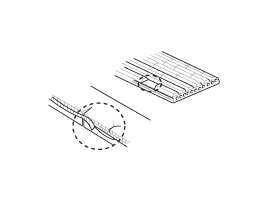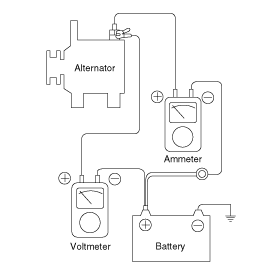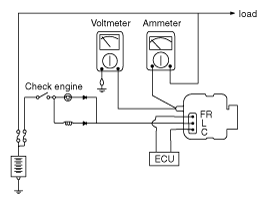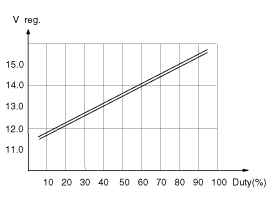 Hyundai Azera: Repair procedures
Fifth generation HG (2011Ц2024) / Hyundai Azera 2011-2024 Service Manual / Engine Electrical System / Charging System / Repair procedures
Hyundai Azera: Repair procedures
Fifth generation HG (2011Ц2024) / Hyundai Azera 2011-2024 Service Manual / Engine Electrical System / Charging System / Repair procedures
Fifth generation HG (2011Ц2024) / Hyundai Azera 2011-2024 Service Manual / Engine Electrical System / Charging System / Repair procedures
| On-vehicle Inspection |
|
Check Battery Voltage
| 1. |
If 20 minutes have not passed since the engine was stopped,
turn the ignition switch ON and turn on the electrical system (headlamp,
blower motor, rear defogger etc.) for 60 seconds to remove the surface
charge. |
| 2. |
Turn the ignition switch OFF and turn off the electrical systems. |
| 3. |
Measure the battery voltage between the negative (-) and positive (+) terminals of the battery.
If the voltage is less than specification, charge the battery. |
Check The Battery Terminals And Fuses
| 1. |
Check that the battery terminals are not loose or corroded. |
| 2. |
Check the fuses for continuity. |
Inspect Drive Belt
Visually check the belt for excessive wear, frayed cords etc.
If any defect has been found, replace the drive belt.
Cracks on the rib side of a belt are considered acceptable. If the belt has chunks missing from the ribs, it should be replaced. |

Visually Check Alternator Wiring And Listen For Abnormal Noises
| 1. |
Check that the wiring is in good condition. |
| 2. |
Check that there is no abnormal noise from the alternator while the engine is running. |
Check Discharge Warning Light Circuit
| 1. |
Warm up the engine and then turn it off. |
| 2. |
Turn off all accessories. |
| 3. |
Turn the ignition switch "ON". Check that the discharge warning light is lit. |
| 4. |
Start the engine and Check that the light goes off.
If the light does not go off as specified, troubleshoot the discharge light circuit. |
Inspect Charging System
| Voltage Drop Test Of Alternator Output Wire |
This test determines whether or not the wiring between the
alternator "B" terminal and the battery (+) terminal is good by the
voltage drop method.
Preparation
| 1. |
Turn the ignition switch to "OFF". |
| 2. |
Disconnect the output wire from the alternator "B" terminal.
Connect the (+) lead wire of ammeter to the "B" terminal of alternator
and the (-) lead wire of ammeter to the output wire. Connect the (+)
lead wire of voltmeter to the "B" terminal of alternator and the (-)
lead wire of voltmeter to the (+) terminal of battery.
|
Test
| 1. |
Start the engine. |
| 2. |
Turn on the headlamps and blower motor, and set the engine speed until the ammeter indicates 20A.
And then, read the voltmeter at this time. |
Result
| 1. |
The voltmeter may indicate the standard value.
|
| 2. |
If the value of the voltmeter is higher than expected (above
0.2V max.), poor wiring is suspected. In this case check the wiring from
the alternator "B" terminal to the battery (+) terminal. Check for
loose connections, color change due to an over-heated harness, etc.
Correct them before testing again. |
| 3. |
Upon completion of the test, set the engine speed at idle.
Turn off the headlamps, blower motor and the ignition switch. |
Output Current Test
This test determines whether or not the alternator gives an output current that is equivalent to the normal output.
Preparation
| 1. |
Prior to the test, check the following items and correct as necessary.
Check the battery installed in the vehicle to ensure that it
is in good condition. The battery checking method is described in the
section "Battery".
The battery that is used to test the output current should be
one that has been partially discharged. With a fully charged battery,
the test may not be conducted correctly.
Check the tension of the alternator drive belt. The belt tension check method is described in the section "Inspect drive belt". |
| 2. |
Turn off the ignition switch. |
| 3. |
Disconnect the battery ground cable. |
| 4. |
Disconnect the alternator output wire from the alternator "B" terminal. |
| 5. |
Connect a DC ammeter (0 to 150A) in series between the "B"
terminal and the disconnected output wire. Be sure to connect the (-)
lead wire of the ammeter to the disconnected output wire.
|
| 6. |
Connect a voltmeter (0 to 20V) between the "B" terminal and
ground. Connect the (+) lead wire to the alternator "B" terminal and (-)
lead wire to a good ground. |
| 7. |
Attach an engine tachometer and connect the battery ground cable. |
| 8. |
Leave the engine hood open.
|
Test
| 1. |
Check to see that the voltmeter reads as the same value as
the battery voltage. If the voltmeter reads 0V, and the open circuit in
the wire between alternator "B" terminal and battery (+) terminal or
poor grounding is suspected. |
| 2. |
Start the engine and turn on the headlamps. |
| 3. |
Set the headlamps to high beam and the heater blower switch
to HIGH, quickly increase the engine speed to 2,500 rpm and read the
maximum output current value indicated by the ammeter.
|
Result
| 1. |
The ammeter reading must be higher than the limit value. If
it is lower but the alternator output wire is in good condition, remove
the alternator from the vehicle and test it.
|
| 2. |
Upon completion of the output current test, lower the engine speed to idle and turn off the ignition switch. |
| 3. |
Disconnect the battery ground cable. |
| 4. |
Remove the ammeter and voltmeter and the engine tachometer. |
| 5. |
Connect the alternator output wire to the alternator "B" terminal. |
| 6. |
Connect the battery ground cable. |
Regulated Voltage Test
The purpose of this test is to check that the electronic voltage regulator controls voltage correctly.
Preparation
| 1. |
Prior to the test, check the following items and correct if necessary.
Check that the battery installed on the vehicle is fully
charged. The battery checking method is described in the section
"Battery".
Check the alternator drive belt tension. The belt tension check method is described in the section "Inspect drive belt". |
| 2. |
Turn ignition switch to "OFF". |
| 3. |
Disconnect the battery ground cable. |
| 4. |
Connect a digital voltmeter between the "B" terminal of the
alternator and ground. Connect the (+) lead of the voltmeter to the "B"
terminal of the alternator. Connect the (-) lead to good ground or the
battery (-) terminal. |
| 5. |
Disconnect the alternator output wire from the alternator "B" terminal. |
| 6. |
Connect a DC ammeter (0 to 150A) in series between the "B" terminal and the disconnected output wire.
Connect the (-) lead wire of the ammeter to the disconnected output wire. |
| 7. |
Attach the engine tachometer and connect the battery ground cable.
|
Test
| 1. |
Turn on the ignition switch and check to see that the voltmeter indicates the following value.
If it reads 0V, there is an open circuit in the wire between
the alternator "B" terminal and the battery and the battery (-)
terminal. |
| 2. |
Start the engine. Keep all lights and accessories off. |
| 3. |
Run the engine at a speed of about 2,500 rpm and read the voltmeter when the alternator output current drops to 10A or less |
Result
| 1. |
If the voltmeter reading agrees with the value listed in the
regulating voltage table below, the voltage regulator is functioning
correctly. If the reading is other than the standard value, the voltage
regulator or the alternator is faulty.
Regulating Voltage Table (Internal mode)
|
| 2. |
Upon completion of the test, reduce the engine speed to idle, and turn off the ignition switch. |
| 3. |
Disconnect the battery ground cable. |
| 4. |
Remove the voltmeter and ammeter and the engine tachometer. |
| 5. |
Connect the alternator output wire to the alternator "B" terminal. |
| 6. |
Connect the battery ground cable.
Regulating Voltage Table (External mode)
|
 Description and Operation
Description and Operation
Description
The charging system includes a battery, an alternator with a built-in regulator, and the charging indicator light and wire.
The Alternator has built-in diodes, each rectifying AC curre ...
 Alternator Repair procedures
Alternator Repair procedures
Removal and Installation
1.
Disconnect the battery negative terminal.
2.
Remove the engine cover.
3.
Disconnect the alternator connector (A) and the cable (B) from the 'B' terminal.
4 ...
See also:
Water Pipe Components and Components Location
Components
1. Water center pipe2. O-ring
...
SRS Control Module (SRSCM) Repair procedures
Removal
1.
Remove the ignition key from the vehicle.
2.
Disconnect the battery negative cable and wait for at least three minutes before beginning work.
3.
Remove the floor console.
(Ref ...
Door Lamp Repair procedures
Removal
Mood lamp
1.
Disconnect the negative (-) battery terminal.
2.
Remove the front door trim panel.
(Refer to Body - "Front Door Trim")
3.
Remove the connector(A) and door LED mood l ...
Categories
Hyundai Azera Manuals
© 2011-2024 Copyright www.hgmanual.com





